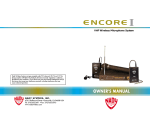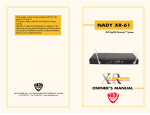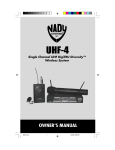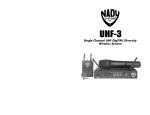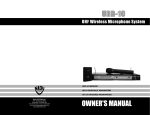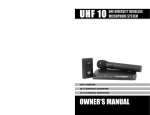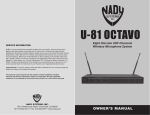Download Nady Systems Encore Duet User's Manual
Transcript
Dual Receiver VHF Wireless Microphone System Nady Wireless Systems are type accepted under FCC rules parts 90, 74 and 15. The device complies with RSS-210 of Industry & Science Canada. Operation is subject to the following two conditions: (1) this device may not cause harmful interference and (2) this device must accept any interference received, including interference that may cause undesired operation. NADY SYSTEMS, INC. 6701 Shellmound Street • Emeryville, CA 94608 USA Tel: 510/652-2411 • Fax: 510/652-5075 www.nady.com CONTENTS CONTENTS ...........................................................................................2 INTRODUCTION ....................................................................................3 USING THIS MANUAL ...........................................................................3 SYSTEM FEATURES ................................................................................4 ENCORE DUET RECEIVER .......................................................................5 WHT HANDHELD MICROPHONE TRANSMITTER .....................................8 WLT LAVALIER/LAPEL OR HEADWORN MICROPHONE BODYPACK TRANSMITTER ...................................................................10 WGT INSTRUMENT BODYPACK TRANSMITTER .....................................12 THE LINK 2™ PLUG-IN TRANSMITTER. ..................................................14 SPECIFICATIONS .................................................................................17 SERVICE ..............................................................................................18 2 INTRODUCTION ENCORE DUET RECEIVER Reception Mode Controls Connectors LED Indicators Dimensions (Max.) Weight Power Requirements Antenna Dual receivers (Channel A and Channel B) Power ON/OFF, dual volume and mute controls (one each, Ch A/B) Dual balanced XLR and unbalanced adjustable 1/4" audio out jacks (Ch A & B mixed), 2.1mm barrel-type DC input jack Power ON, Dual 5-LED RF & AF level displays (Ch A/B) 1.75" x 7.5" x 8.1" (4.4 x 19 x 20.7 cm) 1.6 lbs (.73 kg) 12V @ 400mA, nominal, AC/DC adapter supplied 11.2" (28.5 cm), dual telescopic SERVICE Thank you for purchasing a Nady Encore DUET dual receiver wireless microphone system and congratulations on your choice. The Encore DUET is loaded with top professional operating features and is the best performance and price value available in VHF dual receiver wireless systems. USING THIS MANUAL This booklet gives instructions for the operation of the Encore DUET VHF wireless, including handheld, instrument, lavalier, headmic and plug-in transmitter systems. Please read the instructions for your system completely before operating unit. This manual will first list the features of the Encore DUET and then will take you step by step to show you how to operate your new system. After reading the receiver instructions, turn to the section of the booklet that covers the type of transmitters used with your new system. Each section will give you detailed operating instructions. Also included in this manual are system specifications and servicing information. (U.S.) Should your Nady Encore DUET Wireless Microphone System require service, please contact the Nady Service Department via telephone at (510) 652-2411 or e-mail to [email protected] for a Return Authorization (R/A) Number and a service quote (if out of warranty). Make sure the R/A Number is clearly marked on the outside of the package and enclose a cashier’s check or money order (if not prepaid with a credit card). Ship the unit prepaid to: Nady Systems, Inc., Service Department, 6701 Shellmound Street, Emeryville, CA 94608. Include a brief description of the problems you are experiencing. The warranty card enclosed with this system contains additional valuable warranty and service information. Keep it in a safe place for future possible reference. Do not attempt to service this unit yourself as it will void the warranty. (International) For service, please contact the Nady distributor in your country through the dealer from whom you purchased this product. 18 3 SPECIFICATIONS SYSTEM FEATURES • Dual channel system for simultaneous operation of two transmitters • Available on 2 selected frequencies in the VHF high band (171-216 MHz) for interference-free, long-range performance • Proprietary companding circuitry for an industry-best 120dB Dynamic Range, and the clearest, most natural sound available • Operating Range: Up to 250 feet typical (depending on site conditions) – up to 500+ feet line-of-sight • Noise-free transmitter ON-OFF operation • Rugged, foam-padded traveling case provides easy, safe transport and storage ENCORE DUET RECEIVER • Half-rack dual receiver design (Channel A and Channel B) with retractable front panel dual antennas • Dual RF and AF 5-LED displays for monitoring incoming signal strength and audio level on both channels • Dual balanced XLR and unbalanced adjustable 1/4" jack outputs • Dual mute (squelch) adjust controls • Externally powered by AC/DC power adapter • Unique snap-out panel locking tabs for single receiver or double receiver (side-by-side) optional rack mounting WHT HANDHELD MIC TRANSMITTER • Features the Nady DM -10D unidirectional neodymium dynamic cartridge for optimum true sound, maximum feedback rejection and minimal handling noise • OFF/STANDBY/ON switch allows convenient audio muting with the transmitter "ON" • Low battery LED indicator flashes once for unit "ON"; lights steady for low battery alert • Rubber, "easy-mount" mic clip included WGT & WLT BODYPACK TRANSMITTERS • Choice of instrument (WGT) or headworn/lavalier microphone (WLT) bodypack transmitter • OFF/STANDBY/ON switch allows convenient audio muting with the transmitter "ON" • Low battery LED indicator flashes once for unit "ON"; lights steady for low battery alert • Locking 3.5mm mini-jack provides secure connection for removable microphone or instrument cable • Easily accessible input level adjust control for optimum sound LINK 2™ PLUG-IN TRANSMITTER • Plug-in transmitter converts your favorite XLR handheld or lavalier microphone to wireless instantly • Rugged construction and positive locking connector for reliable performance • Selectable phantom power and LO/HI audio input level • Optional leatherette pouch with clip available for use as bodypack 4 ENCORE DUET OVERALL SYSTEM PERFORMANCE Frequency Response Dynamic Range Total Harmonic Distortion RF Carrier Frequency Range Frequency Stability Modulation Operating Range 25-20,000 Hz, +/-3dB 120dB < 0.3% 2 channels between 169-216 MHz +/- 0.005%, crystal controlled FM (F3E), +/-20KHz max. Up to 250 ft. typical (depending on site conditions); up to 500+ feet optimum line-of-sight TRANSMITTERS Audio Inputs •WHT •WLT/WGT Nady DM-10D neodymium dynamic cartridge 3.5mm mono locking jack for connecting to omni or unidirectional lavalier mic or unidirectional head worn mic, with phantom power (WLT); or connecting to instrument cable (WGT) •LINK 2™ Locking XLR jack for connecting to microphone or cable, with selectable phantom power Controls •WHT OFF/STANDBY/ON switch •WLT/WGT OFF/STANDBY/ON switch, input level adjust •LINK 2™ OFF/STANDBY/ON, LO/HI Level, and ON/OFF Phantom power switch LED Indicator Unit "ON" (single flash), Low Battery Alert (steady) RF Power Out 50mW (Max. allowed by FCC) Harmonic & Spurious Emissions > –40dB Battery 9V Alkaline Battery Life Up to 15 hours Dimensions •WHT 9.5" X 1.4" Diam. (24.1 X 3.5 cm) •WLT/WGT 4.1" X 2.4"X 0.8" (10.4 X 6.1 X 2.0 cm) •LINK 2™ 4.5" X 1.5" X 1.25" (11.4 X 3.8 X 3.2 cm) Weight (w/o battery) •WHT 6.9 oz (193 g) •WLT/WGT 3.6 oz (101 g) •LINK 2™ 2.6 oz (71 g) 17 ENCORE DUET RECEIVER 1. Rackmounting the Receiver There are 2 options available for rackmounting the Encore DUET receiver: singly or side-by-side with another Encore Series receiver. a. Single mounting: Remove the receiver SIDE MOUNT CLIP (1) from each side of the receiver (as shown) and slide in the optional ERM-12 RACK EARS (9). b. Side-by-side double mounting: After removing the SIDE MOUNT CLIPS (1) from both Encore receivers, join the two receivers with the EJC-2 JOINING CLIP (10) and attach the ERM-22 RACK EARS (12) as shown. (Note: Do not mount the receiver in a rack directly above an amplifier or other source of high heat – this could degrade the performance of the Encore DUET. Always ensure adequateairflow and heat dissipation in any rack configuration.) 38 44 2. Powering the Receiver Plug the 12V AC/DC ADAPTER (15) provided into the DC INPUT JACK (11) on the back of the receiver. Then plug the power supply into an AC outlet. (Note: Any 12V DC source with 400mA capability can also be used.) Press the POWER SWITCH (8) once to turn on the receiver. The POWER ON LED (7) will now light and the receiver is operational. 43 36 37 41 45 39 40 42 36 37 38 XLR Connector – Connects microphone to the transmitter module for signal input Locking Ring – Locks microphone to the transmitter Optional Pouch – For lavalier bodypack operation (with beltclip and strap ring for securing) 39 40 41 Gain Control Switch – Adjusts the input sensitivity (LO or HI) Low Battery LED – Single flash (power on), lit steady (low battery) Power Switch – Turns the power ON/STANDBY/OFF. In standby position, the power is on and the audio is off. 42 43 44 45 16 Phantom Power ON/OFF Switch – Turns the phantom power ON/OFF 3. Antennas The Encore DUET receiver is supplied with TELESCOPIC ANTENNAS (16), one each for Channel A and Channel B. These should be extended fully to obtain maximum range. Optimal antenna position is 45 degrees from the receiver (at 90 degrees from each other). For maximum range, it is always best to maintain a line of sight (no obstructions) between the receiver antennas and the transmitter at all times whenever possible. 4. Mute (Squelch) Adjustment In normal operation, the MUTE CONTROLS (2) for each channel (A & B) should be set fully counterclockwise to the factory preset minimum RF level. However, in areas of high RF activity, the mutes (or squelches, as they are sometimes called) may need to be adjusted to compensate for the adverse conditions in a particular location. If, with the transmitter off, one or more LEDs of the receiver's 5 LED RF LEVEL DISPLAYS (4) for that channel transmitter flicker or stay on, the squelch control for that channel should be turned clockwise until the LEDs extinguish. When the squelch is properly adjusted, the RF LEVEL LED displays will only light when that channel transmitter is turned on. Turning the squelch control too far clockwise will reduce the range, but yield a quieter mute (squelch) function. When the 5 LED RF LEVEL display extinguishes, the transmitter for that channel is out of range for that given location, and the user should move closer to the receiver to re-establish the radio link. Battery Compartment Release Button – Press to release XLR connector 9V Alkaline Battery 5 5. Connecting the Audio Output The Encore DUET receiver provides both a fixed mic level BALANCED AUDIO OUTPUT XLR (14) for each channel and an adjustable line level A + B UNBALANCED AUDIO OUTPUT 1/4" JACK (13) which provides a mixed (summed) Ch A plus Ch B output signal. The mixed level from the A + B UNBALANCED OUTPUT is controlled by the rear panel VOLUME CONTROLS (6) for each channel. (Note: As when making any connection, make sure the amplifier or mixing board volume is at the minimum level before plugging in the receiver to avoid possible sound system damage. Also make sure that the phantom power on the input of the mixer is turned OFF before making connection to the receiver.) a. Instrument Connection (using the WGT instrument transmitter) Insert an audio cord with a 1/4" mono phone plug in the A + B UNBALANCED OUTPUT JACK (13) on the rear panel of the receiver. Plug the other end of the cord into an amplifier, effects, or mixing board. Adjust the appropriate VOLUME CONTROL (6) for the channel being used on the Encore DUET receiver clockwise to about 3/4 rotation, until the mixed volume level is comfortable for your application. This setting is roughly equivalent to a direct instrument cord connection. Turning the volume up to maximum will provide 4dB gain over a cord. (Note: Since this a mixed output of Ch A & Ch B, both channels with be processed simultaneously by the amplifier and/or effects connected to, which may not be appropriate for your application. b. Microphone Connection (using the WLT transmitter with either a headset or lavalier microphone or the WHT handheld microphone transmitter) For microphone use, either the BALANCED MIC AUDIO OUTPUT XLRs (14) or the 1/4" line level A + B UNBALANCED OUTPUT (13) can be used. The XLR output is set at a non-adjustable microphone level, similar to hardwired mic levels. Plug an XLR connector into either or both of the XLR OUTPUT JACKS on the rear of the unit and plug the other end into your amplifier or mixing board. (Note: Make sure the phantom power on your mixing board is turned off and the volume is turned down when making connections.) For your convenience, the XLR output levels are preset at the factory and are not adjustable with the receiver volume controls. To use the 1/4" A + B UNBALANCED OUTPUT JACK (13), follow the instructions for the Instrument Connection(above), except start with the receiver volume at 1/2 MAX and adjust the volume control for each channel until the mixed Ch A & Ch B volume level is optimal. If the volume controls are set too high, you may overload your mixer or amp. 6 4. Microphone Operation a. Turn on the Link 2 by sliding the ON/STANDBY/OFF SWITCH (41) to the STANDBY position (transmitter on, audio muted) or the ON position (transmitter and audio both on). The LOW BATTERY INDICATOR LED (40) will give a single quick flash, indicating usable battery strength. In case of dead or low battery, the indicator will either not go on at all or stay on continuously, indicating a battery voltage below 7V. If this occurs, replace with fresh 9V battery. Remember to turn the transmitter off when not in use. b. The Link 2 is now ready to use. Most or all of the RF DISPLAY LEDs (4) on that channel of the Encore DUET receiver should now be lit, indicating a received signal from that transmitter. When ready to speak, slide the transmitter switch to the ON position and adjust the volume of that channel of the receiver as per the Audio Output Microphone Connection section of the above Encore DUET receiver instructions. The appropriate AF LEVEL LED DISPLAY (5) on the Encore DUET receiver will light up to 5 LEDs (4 green and 1 red) for all input signals. Occasional flickering on and off during use of the top red LED indicator in this display is normal, however if the red LED stays on continuously, it means the signal is too loud and there is the possibility of overload distortion. Re-position the microphone farther from the source or adjust the Link 2 transmitter gain with the VOLUME LO/HI GAIN SWITCH (39). Set for the maximum possible level without noticeable distortion on the high level peaks. Set the GAIN SWITCH to LO to decrease the audio level, and set the GAIN SWITCH to HI to increase the audio level. The red LED indicator should flicker only on the loudest inputs. (Note: Observe care in selecting P.A. volume, transmitter location and speaker placement so that acoustic feedback (howling and screeching) will be avoided. Please also observe the pickup patterns of the microphone selected: omnidirectional mics pick up sound equally from all directions and are prone to feedback if not used carefully. Unidirectional mics are more resistant to feedback, but pick up sound sources best that are directly in front of the mic. Also, mics that are farther from the sound source, such as lavaliers, require more acoustic gain and thus are also more prone to feedback than close-source mics such as handheld or headworn mics that are used close to the mouth.) (Note: Microphone elements can easily be destroyed by the buildup of salts and minerals from perspiration and saliva. It is good practice to put 15 THE LINK 2™ PLUG-IN TRANSMITTER 16 16 1. Transmitter Set-Up First, slide open the BATTERY COMPARTMENT DOOR (43) to expose compartment. Insert a fresh 9V ALKALINE BATTERY (45), observing polarity. Close the battery compartment door. 2. Handheld Microphone Installation • Step 1 - Rotate the transmitter's threaded LOCKING RING (37) clockwise toward the XLR CONNECTOR (36) until it stops. • Step 2 - Hold your mic in one hand and The Link 2 in the other. • Step 3 - Plug your mic into the XLR CONNECTOR. • Step 4 - Lock the mic into place with the adjustable threaded LOCKING RING by rotating the ring, counterclockwise, to the top of the transmitter. • Step 5 - To release the XLR CONNECTOR, turn the threaded LOCKING RING clockwise and press the RELEASE BUTTON (44). 7 8 4 5 5 4 3. Lavalier Microphone Installation The lavalier microphone you are using must terminate with an XLR connector and conform to the pin assignments shown below. If it does not conform or is supplied with a different connector, you must use an appropriate adapter or the lav mic may not work with the Link 2. If you have any questions, please contact your Nady dealer or Nady Systems’ Customer Service Department. Note: The pin assignments on The Link 2’s XLR connector are as shown: 2 14 6 13 11 6 14 15 2 1 9 9 Note: Select phantom power, as needed, with the PHANTOM POWER ON/OFF SWITCH (42). 1 12 10 12 14 7 WHT HANDHELD MICROPHONE TRANSMITTER 32 1. Unscrew the BATTERY COMPARTMENT COVER (17) and remove, exposing the BATTERY HOLDER (18). Insert a fresh 9V ALKALINE BATTERY (19), observing the correct polarity as marked, and screw the cover back on to the microphone. Make sure the cover is screwed on completely. A fresh alkaline battery can last up to 16 hours in use, but in order to ensure optimum performance, it is recommended that you replace the battery after every 10 hours of use. 35 34 33 32 2. Turn on the WHT by sliding the OFF/STANDBY/ON SWITCH (20) to the STANDBY position (transmitter on, audio muted) or the ON position (transmitter and audio both on). The BATTERY INDICATOR LED (21) will give a single quick flash, indicating usable battery strength. In the case of a dead or low battery, the LED will either not go on at all or will stay on continuously, indicating that the battery should be replaced with a fresh one. To preserve battery life, turn the transmitter off when not in use. 30 3. The microphone is now ready to use. Most or all of the RF LEVEL DISPLAY LEDs (4) on the Encore Duet receiver should now be lit, indicating a received signal from the transmitter. When ready to speak, slide the transmitter switch to the ON position. Adjust the volume of the receiver as per the Audio Output Microphone Connection section of the above Encore Duet receiver instructions. The AF LEVEL LED DISPLAY (5) on the Encore Duet receiver will light up to 5 LEDs (4 green and 1 red) for all input signals. Occasional flickering on and off during use of the top red LED indicator in this display is normal, however if the red LED stays on continuously, it means the signal is too loud and there is the possibility of overload distortion. Back off from the microphone until the red LED indicator only flickers on peaks. [Note: Observe care in selecting P.A. volume, transmitter location and speaker placement so that acoustic feedback (howling or screeching) will be avoided.] [Note: Microphone elements can easily be destroyed by the buildup of salts and minerals from perspiration and saliva. It is good practice to put a windscreen on the mic element at all times to protect it.] 30 Opening Battery Compartment 31 8 13 WGT INSTRUMENT BODYPACK TRANSMITTER 1. Snap open the BATTERY COMPARTMENT (30) and insert a fresh 9V BATTERY (31), observing the correct polarity. Close the compartment. The WGT is provided with a 3.5 mm LOCKING JACK (32) for connecting the INSTRUMENT CABLE (35). To secure the connection, turn the metal slip ring on the plug clockwise to thread it on to the jack. To unplug, reverse the process. Slip the transmitter into a pocket or clip on to your clothes or instrument strap. (Note: As the cord to the instrument also serves as the antenna, be sure to extend it fully for maximum range. Rolling up or shortening the cord may reduce the effective operating range.) 2. Turn on the WGT by sliding the OFF/STANDBY/ON SWITCH (32) to the STANDBY position (transmitter on, audio muted) or the ON position (transmitter and audio both on). The BATTERY INDICATOR LED (33) will give a single quick flash, indicating usable battery strength. In the case of a dead or low battery, the LED either will not go on at all or will stay on continuously, indicating that the battery should be replaced with a fresh one. 3. The WGT transmitter is now ready to use. Most or all of the RF DISPLAY LEDs (4) on the Encore Duet receiver should now be lit, indicating a received signal from the transmitter. Adjust the volume of the receiver as per the Audio Output Instrument Connections section of the above Encore Duet receiver instructions. For optimum performance, an INPUT LEVEL CONTROL (34) is provided on the top panel of the WGT. Adjust the gain by turning the control with a small slot head screwdriver. It is recommended that this control be turned to maximum gain. However, for ultra high-gain instrument sources such as active bass pickups or even extra hot guitar pickups, turning the level down slightly will create a cleaner sound. (Note: Turning down the input gain too much can compromise the signal-to-noise ratio and is not recommended. Set for the maximum possible gain and headroom without noticeable distortion on the high level peaks). The AF LEVEL LED DISPLAY (5) on the Encore Duet receiver will light up to 5 LEDs (4 green and 1 red) for all input signals. Occasional flickering on and off during use of the top red LED indicator in this display is normal, however if the red LED stays on continuously, turn down the instrument volume or adjust the INPUT LEVEL CONTROL (34) on the WGT transmitter, or noticeable distortion may result. (Note: Scratchy noises can sometimes occur when some electric guitars/basses with dirty pots or connections are used with any wireless system. For this reason, the supplied INSTRUMENT CORD (35) has a factory installed capacitor inside the 1/4" plug. This capacitor provides first order filtering of the RF signal from the cord into the guitar and eliminates virtually all scratchy noises. Should your equipment still give you scratchy noises, we suggest these steps to eliminate them: 1) Make sure all guitar volume and tone pots are clean and all contacts are solid – this is very important. 2) Provide extra filtering with a 220 pF capacitor soldered across the hot to ground terminals of the guitar's volume and tone pots.) 12 21 20 18 19 17 9 WLT LAVALIER/LAPEL OR HEADWORN MICROPHONE BODYPACK TRANSMITTER 24 1. Snap open the BATTERY COMPARTMENT (22) and insert a fresh 9V BATTERY (23), observing the correct polarity. Close the compartment. 2. The WLT is provided with a 3.5 mm LOCKING JACK (24) for connecting the microphone. Plug in either the LAVALIER/LAPEL (25) or the HEADWORN MICROPHONE (26), as supplied. To secure the connection, turn the metal slip ring on the plug clockwise to thread it on to the jack. To unplug, reverse the process. Slip the transmitter into a pocket or clip on to your clothes. To use the lavalier mic, attach it at chest level. Do not place too close to the mouth – a distance of about six inches usually works best. To use the headworn mic, place it on the head and adjust the mic boom so that the mic is about one inch to the side of the front of the mouth. (Note: The lavalier or headworn mic wire is also the transmit antenna, and rolling up or shortening the wire may reduce the effective operating range. Extend the wire fully during use, and keep it as straight as possible.) 29 28 27 22 25 3. Turn on the WLT by sliding the OFF/STANDBY/ON SWITCH (27) to the STANDBY position (transmitter on, audio muted) or the ON position (transmitter and audio both on). The BATTERY INDICATOR LED (28) will give a single quick flash, indicating usable battery strength. In the case of a dead or low battery, the LED either will not go on at all or will stay on continuously, indicating that the battery should be replaced with a fresh one. 26 4. The microphone is now ready to use. Most or all of the RF DISPLAY LEDs (4) on the Encore Duet receiver should now be lit, indicating a received signal from the transmitter. When ready to speak, slide the transmitter switch to the ON position and adjust the volume of the receiver as per the Audio Output Microphone Connection section of the above Encore Duet receiver instructions. The AF LEVEL LED DISPLAY (5) on the Encore Duet receiver will light up to 5 LEDs (4 green and 1 red) for all input signals. Occasional flickering on and off during use of the top red LED indicator in this display is normal, however if the red LED stays on continuously, it means the signal is too loud and there is the possibility of overload distortion. Re-position the microphone farther from the source or adjust the AUDIO INPUT LEVEL CONTROL (29) until the red LED indicator flickers only on the loudest inputs. (Note: Observe care in selecting P.A. volume, transmitter location and speaker placement so that acoustic feedback (howling and screeching) will be avoided. Please also observe the pickup patterns of the microphone selected: omnidirectional mics pick up sound equally from all directions and are prone to feedback if not used carefully. Unidirectional mics are more resistant to feedback, but pick up sound sources best that are directly in front of the mic. Also, mics that are farther from the sound source, such as lavaliers, require more acoustic gain and thus are also more prone to feedback than close-source mics such as handheld or headworn mics that are used close to the mouth.) (Note: Microphone elements can easily be destroyed by the buildup of salts and minerals from perspiration and saliva. It is good practice to put a windscreen on the mic element at all times to protect it.) 10 Opening Battery Compartment 22 23 11














